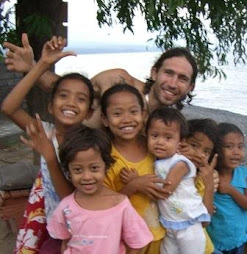
It has been said that if work is what liberates women, then African women are the most liberated in the world. After all, they do produce over 70% of the continent’s food, as women usually cultivate the crops and tend to the fields. As for trade, women dominate the market economy of the village as well. Throughout West Africa , I have witnessed firsthand the tireless work ethic of African women, as they always seem to be tending to the fields, stooped over a fire or carrying something on their heads: a basket of bananas, firewood, dried fish or peanuts. Women (and girls) are responsible for fetching water, which is the most strenuous task in much of Africa , and they are also responsible for raising the children, preparing the food and tending the household. Hard work indeed.
There are prominent examples of African women reaching positions of power: the president of Liberia Ellen Johnson-Sirleaf and recent Nobel Peace Prize winner Wangari Maathai from Kenya are two of the most inspiring examples. While in the Senegalese capital of Dakar , I worked with professional television producers, lawyers, nurses and development workers – all impressive, dynamic African women. But in many parts of West Africa , women still face an uphill battle. Though opportunities for advancement have grown in urban settings, the sad truth is that in rural villages, there is little hope for advancement. Here in Nder, a small village in the arid northern region of Senegal , the literacy rate hovers around 10% and most women are more concerned with putting food on the table than anything else.
Located in the Sahel region, Nder suffers from limited rainfall and poor soils. Faced with worsening climate conditions, it is getting more and more difficult for families to produce enough food to subsist on. Perhaps the biggest obstacle to increased food production is the lack of capital needed to invest in a second crop, one that can be planted and harvested in the off-season. The growing cycle in Senegal is seasonal: during the rainy season, the community plants and harvests vegetables such as potatoes, tomatoes and millet. But in the off-season, they could be growing a cash crop like peanuts to supplement their families’ income, as peanuts grow well with less rainwater. The problem is that such an endeavor requires an investment in seed, fertilizer, etc.
Enter SEM ( Senegal Eco-village Microfinance), a non-governmental organization that provides low-interest loans to local communities looking to create new businesses. Just like the last project I supported in Cape Verde with David and his goats, SEM provides micro-finance loans, but distributes them to larger, community-based groups, such as the twenty women of Nder that have banded together to plant a peanut crop for their village.
The women of Nder have a history of standing up and demanding change, as this village was home to a female-led rebellion against colonial French forces during the colonial era. It seems that this fighting spirit is still alive and well today, as the local women have banded together to fight for their village’s survival. Faced with complete isolation (the nearest school and medical clinics are over 50 miles away), the village is suffering from abandonment of men towards the cities. Without a means to provide for their families, men are forced to seek work in the cities, a demographic drift that threatens the sustainability of Nder.
But with the additional income generated by a peanut crop, conditions will improve and the village cohesion will be maintained, as has been the case in so many other villags within the SEM Eco-village network here in Senegal . With a proven track record of success, SEM provides the ideal partner to efficiently administer this loan. On behalf of 100 Friends, I have fulfilled the loan request of Nder’s Womens Group for the amount of $900. This money will go towards the purchase of seed, fertilizer and insecticide to ensure a stable crop of peanuts that can then be sold at the local market to be made into peanut oil for export.
Helping people help themselves is a mantra I try to adhere to. Here in Nder, it’s as plain as day. Due to their isolation and lack of collateral, these villagers would never qualify for a loan from a traditional bank. The simple banking assistance of SEM will allow these women to lead their village to greater prosperity, perhaps ensuring its very survival in the process. I will be receiving (and passing along) field reports from them as soon as the crops are planted and harvested. Once the loan has been repaid, it will go back into the SEM Fund and will be lent to a similar group next year. Money is used to boost a community’s food production, generating income and maintaining social cohesion and then it is recycled and plugged into the grid again. Is there a more logical and simple manner of fighting poverty as that?













